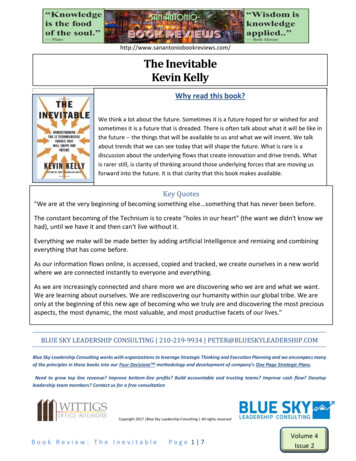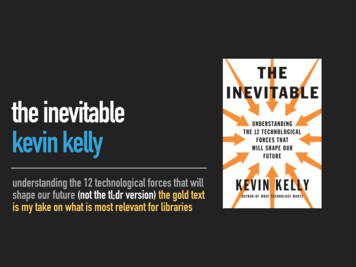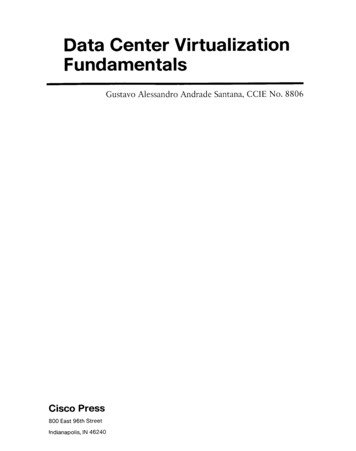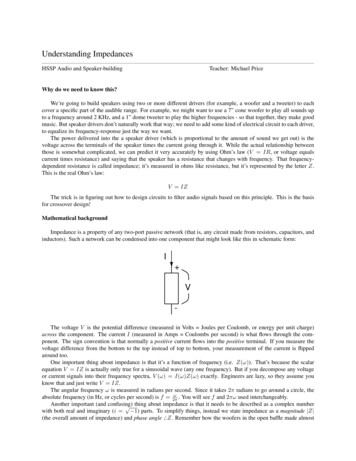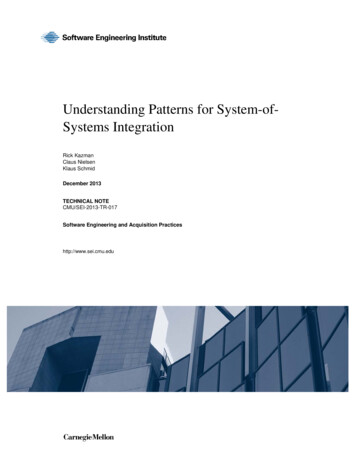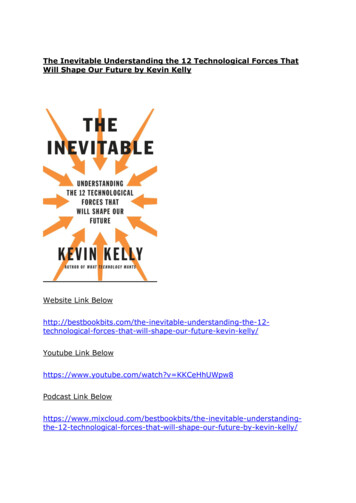
Transcription
The Inevitable Understanding the 12 Technological Forces ThatWill Shape Our Future by Kevin KellyWebsite Link -our-future-kevin-kelly/Youtube Link Belowhttps://www.youtube.com/watch?v KKCeHhUWpw8Podcast Link hat-will-shape-our-future-by-kevin-kelly/
1 BECOMINGTechnological life in the future will be a series of endless upgrades.Endless Newbie is the new default for everyone, no matter your age orexperience.2 COGNIFYINGThree recent breakthroughs have unleashed the long-awaited arrival ofartificial intelligence:1. Cheap Parallel Computation2. Big Data (Every intelligence has to be taught)3. Better AlgorithmsThe advent of AI didn’t diminish the performance of purely human chessplayers. Quite the opposite. Cheap, supersmart chess programs inspiredmore people than ever to play chess, at more tournaments than ever, andthe players got better than ever.There are more than twice as many grand masters now as there werewhen Deep Blue first beat Kasparov.If AI can help humans become better chess players, it stands to reasonthat it can help us become better pilots, better doctors, better judges,better teachers.Some possible new minds:1. A mind like a human mind, just faster in answering (the easiest AImind to imagine).2. A very slow mind, composed primarily of vast storage and memory.3. A global supermind composed of millions of individual dumb minds inconcert.4. A hive mind made of many very smart minds, but unaware it/they area hive.
5. A borg supermind composed of many smart minds that are very awarethey form a unity.6. A mind trained and dedicated to enhancing your personal mind, butuseless to anyone else.7. A mind capable of imagining a greater mind, but incapable of makingit.8. A mind capable of creating a greater mind, but not self-aware enoughto imagine it.9. A mind capable of successfully making a greater mind, once.10.A mind capable of creating a greater mind that can create a yetgreater mind, etc.11.A mind with operational access to its source code, so it canroutinely mess with its own processes.12.A superlogic mind without emotion.13.A general problem-solving mind, but without any self-awareness.14.A self-aware mind, but without general problem solving.15.A mind that takes a long time to develop and requires a protectormind until it matures.16.An ultraslow mind spread over large physical distance that appears“invisible” to fast minds.17.A mind capable of cloning itself exactly many times quickly.18.A mind capable of cloning itself and remaining in unity with itsclones.19.A mind capable of immortality by migrating from platform toplatform.20.A rapid, dynamic mind capable of changing the process andcharacter of its cognition.21.A nanomind that is the smallest possible (size and energy profile)self-aware mind.22.A mind specializing in scenario and prediction making.23.A mind that never erases or forgets anything, including incorrect orfalse information.24.A half-machine, half-animal symbiont mind.25.A half-machine, half-human cyborg mind. A mind using quantumcomputing whose logic is not understandable toTo understand how robot replacement will happen, it’s useful to breakdown our relationship with robots into four categories.
1. Jobs Humans Can Do but Robots Can Do Even BetterHumans can weave cotton cloth with great effort, but automated loomsmake perfect cloth by the mile for a few cents.A computerized brain known as autopilot can fly a 787 jet unaided for allbut seven minutes of a typical flight.We’ve accepted utter reliability in robot manufacturing; soon we’ll acceptthe fact that robots can do it better in services and knowledge work too.2. Jobs Humans Can’t Do but Robots CanWithout automation, we could not make a single computer chip—a jobthat requires degrees of precision, control, and unwavering attention thatour animal bodies don’t possess. Likewise no human—indeed no group ofhumans, no matter their education—can quickly search through all theweb pages in the world to uncover the one page revealing the price ofeggs in Kathmandu yesterday.We aren’t giving “good jobs” to robots. Most of the time we are givingthem jobs we could never do. Without them, these jobs would remainundone.3. Jobs We Didn’t Know We Wanted DoneThis is the greatest genius of the robot takeover: With the assistance ofrobots and computerized intelligence, we already can do things we neverimagined doing 150 years ago.It is a safe bet that the highest-earning professions in the year 2050 willdepend on automations and machines that have not been invented yet.That is, we can’t see these jobs from here, because we can’t yet see themachines and technologies that will make them possible. Robots createjobs that we did not even know we wanted done.4. Jobs Only Humans Can Do—at First
The one thing humans can do that robots can’t (at least for a long while)is to decide what it is that humans want to do.When robots and automation do our most basic work, making it relativelyeasy for us to be fed, clothed, and sheltered, then we are free to ask,“What are humans for?”Industrialization did more than just extend the average human lifespan. Itled a greater percentage of the population to decide that humans weremeant to be ballerinas, full-time musicians, mathematicians, athletes,fashion designers, yoga masters, fan-fiction authors, and folks with oneof-a-kind titles on their business cards. With the help of our machines, wecould take up these roles—but, of course, over time the machines will dothese as well.We’ll then be empowered to dream up yet more answers to the question“What should we do?” It will be many generations before a robot cananswer that.This postindustrial economy will keep expanding because each person’stask (in part) will be to invent new things to do that will later becomerepetitive jobs for the robots.In the coming years robot-driven cars and trucks will become ubiquitous;this automation will spawn the new human occupation for former truckdrivers of trip optimizer, a person who tweaks the traffic algorithms foroptimal energy and time usage.Routine robosurgery will necessitate the new medical skills of keepingcomplex machines sterile.When automatic self-tracking of all your activities becomes the normalthing to do, a new breed of professional analysts will arise to help youmake sense of the data. And of course we will need a whole army of robotnannies, dedicated to keeping your personal robots up and running.
Each of these new vocations will in turn be taken over by automationlater.Here are the Seven Stages of Robot Replacement:1. A robot/computer cannot possibly do the tasks I do.2. [Later.] OK, it can do a lot of those tasks, but it can’t do everything Ido.3. [Later.] OK, it can do everything I do, except it needs me when itbreaks down, which is often.4. [Later.] OK, it operates flawlessly on routine stuff, but I need to train itfor new tasks.5. [Later.] OK, OK, it can have my old boring job, because it’s obviousthat was not a job that humans were meant to do.6. [Later.] Wow, now that robots are doing my old job, my new job ismuch more interesting and pays more!7. [Later.] I am so glad a robot/computer cannot possibly do what I donow.[Repeat.]This is not a race against the machines. If we race against them, we lose.This is a race with the machines. You’ll be paid in the future based on howwell you work with robots.We need to let robots take over.Many of the jobs that politicians are fighting to keep away from robots arejobs that no one wakes up in the morning really wanting to do.Robots will do jobs we have been doing, and do them much better thanwe can.They will do jobs we can’t do at all. They will do jobs we never imaginedeven needed to be done. And they will help us discover new jobs forourselves, new tasks that expand who we are.They will let us focus on becoming more human than we were. It isinevitable.
Let the robots take our jobs, and let them help us dream up new workthat matters.3 FLOWINGHere are eight generatives that are “better than free.”1. IMMEDIACY Sooner or later you can find a free copy of whatever you want, butgetting a copy delivered to your inbox the moment it is released—oreven better, produced—by its creators is a generative asset.2. PERSONALIZATION A generic version of a concert recording may be free, but if youwant a copy that has been tweaked to sound acoustically perfect inyour particular living room—as if it were being performed in yourroom—you may be willing to pay a lot.3. INTERPRETATION As the old joke goes: “Software, free. User manual, 10,000.” Butit’s no joke. A couple of high-profile companies, like Red Hat,Apache, and others make their living selling instruction and paidsupport for free software. The copy of code, being mere bits, isfree. The lines of free code become valuable to you only throughsupport and guidance.4. AUTHENTICITY You might be able to grab a popular software application for free onthe dark net, but even if you don’t need a manual, you might wantto be sure it comes without bugs, malware, or spam. In that caseyou’ll be happy to pay for an authentic copy.5. ACCESSIBILITY Ownership often sucks. You have to keep your things tidy, up-todate, and, in the case of digital material, backed up. And in thismobile world, you have to carry it along with you. Many people,myself included, will be happy to have others tend our“possessions” while we lazily subscribe to them on the cloud.6. EMBODIMENT At its core the digital copy is without a body. I am happy to read adigital PDF of a book, but sometimes it is luxurious to have the
same words printed on bright white cottony paper bound in leather.Feels so good.7. PATRONAGE Deep down, avid audiences and fans want to pay creators. Fanslove to reward artists, musicians, authors, actors, and othercreators with the tokens of their appreciation, because it allowsthem to connect with people they admire. But they will pay onlyunder four conditions that are not often met: It must be extremely easy to do; The amount must be reasonable; There’s clear benefit to them for paying; and It’s clear the money will directly benefit the creators.8. DISCOVERABILITY No matter what its price, a work has no value unless it is seen. When there are millions of books, millions of songs, millions offilms, millions of applications, millions of everything requesting ourattention—and most of it free—being found is valuable.These eight qualities require a new skill set for creators. Success nolonger derives from mastering distribution. Distribution is nearlyautomatic; it’s all streams.The Great Copy Machine in the Sky takes care of that. The technical skillsof copy protection are no longer useful because you can’t stop copying.These are the Four Stages of Flowing:1. Fixed. Rare. The starting norm is precious products that take much expertise tocreate. Each is an artisan work, complete and able to stand alone,sold in high-quality reproductions to compensate the creators.2. Free. Ubiquitous. The first disruption is promiscuous copying of the product,duplicated so relentlessly that it becomes a commodity. Cheap,perfect copies are spent freely, dispersed anywhere there isdemand. This extravagant dissemination of copies shatters theestablished economics.3. Flowing. Sharing.
The second disruption is an unbundling of the product into parts,each element flowing to find its own new uses and to be remixedinto new bundles. The product is now a stream of services issuingfrom the shared cloud. It becomes a platform for wealth andinnovation.4. Opening. Becoming. The third disruption is enabled by the previous two. Streams ofpowerful services and ready pieces, conveniently grabbed at littlecost, enable amateurs with little expertise to create new productsand brand-new categories of products. The status of creation isinverted, so that the audience is now the artist. Output, selection,and quality skyrocket.4 SCREENINGToday more than 5 billion digital screens illuminate our lives.Digital display manufacturers will crank out 3.8 billion new additionalscreens per year.That’s nearly one new screen each year for every human on earth.We will start putting watchable screens on any flat surface.Humans have “published”: at least 310 million books 1.4 billion articles and essays 180 million songs 3.5 trillion images 330,000 movies 1 billion hours of videos, TV shows, and short films, and 60 trillion public web pagesAll this material is currently contained in all the libraries and archives ofthe world.
When fully digitized, the whole lot could be compressed (at currenttechnological rates) onto 50-petabyte hard disks.Ten years ago you needed a building about the size of a small-townlibrary to house 50 petabytes.Today the universal library would fill your bedroom. With tomorrow’stechnology, it will all fit onto your phone.When that happens, the library of all libraries will ride in your purse orwallet—if it doesn’t plug directly into your brain with thin white cords.Some people alive today are surely hoping that they die before suchthings happen, and others, mostly the young, want to know what’s takingso long.What happens when all the books in the world become a single liquidfabric of interconnected words and ideas? Four things:1. First, works on the margins of popularity will find a small audiencelarger than the near zero audience they usually have now.2. Second, the universal library will deepen our grasp of history, as everyoriginal document in the course of civilization is scanned and crosslinked.3. Third, the universal networked library of all books will cultivate a newsense of authority. If you can truly incorporate all texts—past andpresent in all languages—on a particular subject, then you can have aclearer sense of what we as a civilization, a species, do and don’tknow.4. Fourth and
The one thing humans can do that robots can’t (at least for a long while) is to decide what it is that humans want to do. When robots and automation do our most basic work, making it relatively
